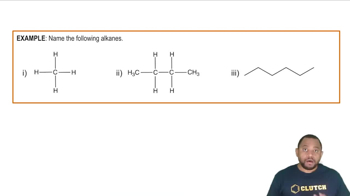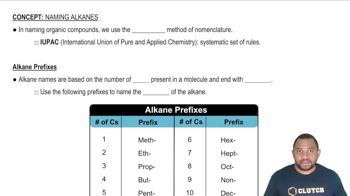Here are the essential concepts you must grasp in order to answer the question correctly.
Alkanes
Alkanes are saturated hydrocarbons consisting only of carbon (C) and hydrogen (H) atoms, connected by single bonds. They follow the general formula CnH2n+2, where 'n' is the number of carbon atoms. Alkanes can be classified into straight-chain and branched-chain forms based on the arrangement of their carbon atoms.
Recommended video:
Straight-Chain Alkanes
Straight-chain alkanes, also known as normal alkanes, have a linear structure where carbon atoms are connected in a continuous chain. This arrangement results in a simple, unbranched molecular structure, such as in butane (C4H10), which has four carbon atoms in a row. Their physical properties, such as boiling points, tend to increase with the length of the carbon chain.
Recommended video:
Branched-Chain Alkanes
Branched-chain alkanes contain one or more carbon branches off the main carbon chain, leading to a more complex structure. For example, isobutane (C4H10) is a branched-chain alkane with a three-carbon chain and a single carbon branch. This branching affects the physical and chemical properties of the alkanes, often resulting in lower boiling points compared to their straight-chain counterparts.
Recommended video:
 Verified step by step guidance
Verified step by step guidance

